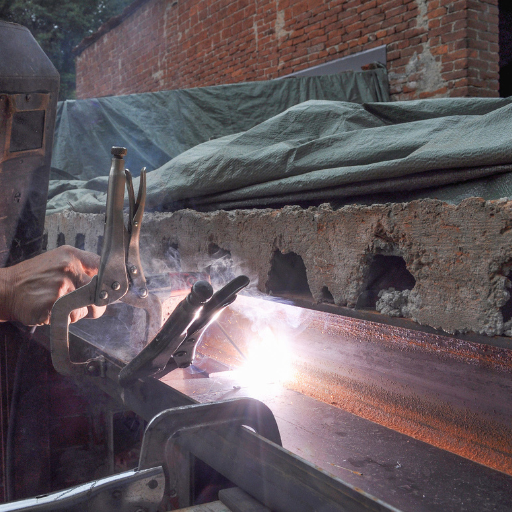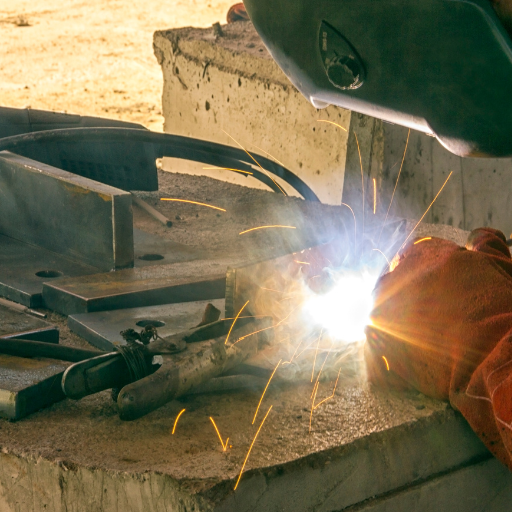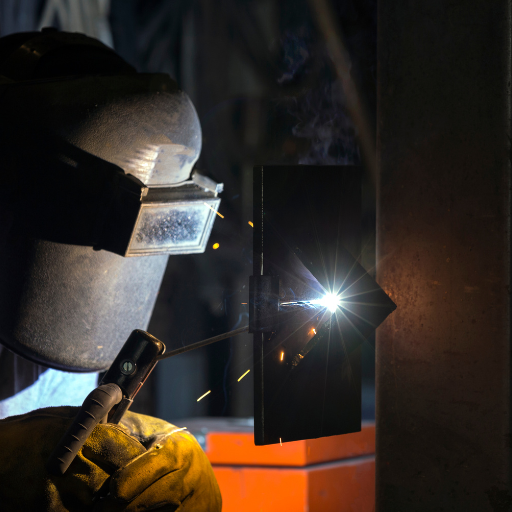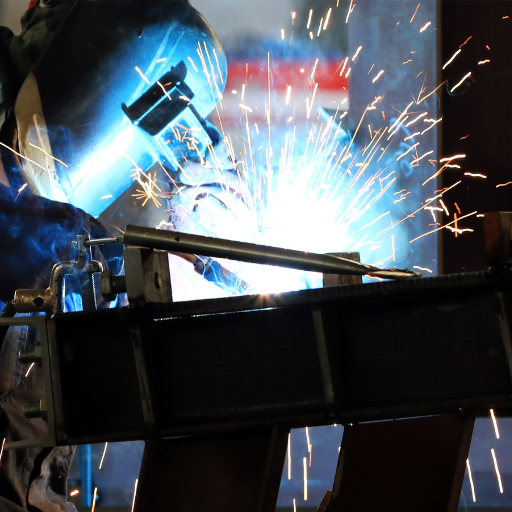Optimum results in welding can only be attained if the right technique is chosen. The two most widely used welding processes are Shielded Metal Arc Welding (SMAW) and Gas Metal Arc Welding (GMAW). Each of these techniques has its own merits, a decision on which one to use depending on many factors including: type of material, project specifications, and working conditions among others. In this article, we will comprehensively compare SMAW versus GMAW by looking at the differences, advantages and disadvantages of each. That way you’ll be able to know which procedure is suitable for your specific needs when it comes to welding. Whether expert or novice in this field, this guide will enlighten you adequately so that you make a good choice.
What are the key differences between SMAW and GMAW?

Mainly, the difference between Shielded Metal Arc Welding (SMAW) and Gas Metal Arc Welding (GMAW) lies in their techniques and equipment employed. Also known as stick welding, SMAW entails use of a consumable electrode coated with flux to make the weld. The coating releases gases which protect the weld from contamination when it melts as a result of electrode melting. It is very versatile, cheap and effective when done outside or during windy weather. Nonetheless, it produces much more slag and requires frequent electrode changes thereby slowing down welding process.
Conversely, GMAW, also called MIG welding uses a continuous wire electrode that is fed through a welding gun along with shielding gas to protect the weld from atmospheric contamination. This method is characterized by high speed of welding, ease of operation as well as minimal post-weld cleaning because it leaves little or no slag behind. On the other hand, GMAW equipment tends to be more costly than SMAW’s due to its low suitability for outdoor environments caused by wind interference with shielding gas.
To sum up,suitable material for SMAW should be able to perform under harsh environmental conditions whereas GMAW is best suited for indoor controlled environment where cleaner fast welds are required
How does shielded metal arc welding (SMAW) work?
Shielded Metal Arc Welding (SMAW), otherwise known as stick welding, is a process that uses a consumable electrode coated in flux. An electric current through the electrode creates an electric arc that has intense heat and melts the electrode together with the base metal. The flux ruptures releasing fumes which act as shields against impurities like oxygen and nitrogen in the atmosphere. The latter is very important for safeguarding the molten weld pool until it solidifies. As soon as it cools down, this molten electrode material fills up the joint, resulting in strong bond between them. Despite creating slag that need to be cleaned after welding, SMAW is liked not only because of its ease and versatility but also due to how effective it is irrespective of where it happens including outside welding.
What is gas metal arc welding (GMAW), also known as MIG welding?
Gas metal arc welding (GMAW) also referred to as Metal Inert Gas (MIG), is a type of welding where a continuous solid wire electrode is used. The wire electrode is heated and fed towards the weld pool from a welding gun. It also supplies shielding gas, usually argon, helium, or mixtures, which prevents the atmospheric gases from contaminating the weld area. This method is liked because of its high efficiency, ease of automation and clean welds with minimum spatter and no slag. GMAW is versatile in that it can be applied on thin and thick materials hence being widely used in automotive, construction as well fabrications industries for its productivity and simplicity. Nonetheless, using this technique outdoors under windy conditions may affect its performance since the shielding gas can easily be disturbed thereby interfering with quality.
Why are these two welding processes different in terms of applications?
Shielded Metal Arc Welding (SMAW) contrasts with Gas Metal Arc Welding (GMAW) in their applications primarily because of the environments they operate in and material compatibility. The flux coating on SMAW is strong enough to make it a better choice for outdoor use and harsh conditions where as GMAW’s shielding gas would be affected by the wind, weather; thus, making it less suitable for such environment. This makes SMAW ideal for building, ship making, and fixing of structures. However, GMAW is preferred in controlled environments like manufacturing facilities due to its higher speed, cleaner welds, and ease of automation—attributes that are vital for production efficiency in automotive, construction, and fabrication industries. Moreover while SMAW can work with a greater number of materials including dirty or rusty metals; GMAW excels at cleaner prepped materials which allow more precise and beautiful looking welds.
How does each welding process perform with different types of metal?

Different types of metals are worked on better by both Shielded Metal Arc Welding (SMAW) and Gas Metal Arc Welding (GMAW) due to their special features. SMAW is highly adaptive as it can be used with several varieties of metals such as steel, stainless steel, cast iron, and aluminum. It is able to tolerate dirty metals, rusty or even painted ones which makes it good for repair and maintenance functions. Conversely, GMAW performs best in clean prepped materials with excellent control and precision especially when it comes to thinner metals or non-ferrous alloys like aluminium and copper. Better looking welds are formed through GMAW which becomes the choice where outlook matters most while carrying out less post-weld cleaning operations. Thusly, while SMAW is the go-to for rugged, field repairs and varied material conditions, GMAW shines in environments requiring precision and high-quality finishes.
How does SMAW handle different metal thicknesses?
Shielded Metal Arc Welding abbreviated as SMAW is very versatile and can be used on metals covering different thicknesses. For thicker metals, SMAW produces deep penetration welds which are required to maintain structural integrity in heavy-duty applications. Welding current adjustment leads to optimization; higher currents are capable of effectively handling thick materials. However, reducing the current in order to avoid burn-through and have a better control of the welding puddle also permits SMAW to work on thinner metals. Nonetheless, because it has high heat input and deep penetration, when using it with thin metals one should be more careful not to damage or warp them. In general, it implies that SMAW is a very adaptable approach that can be employed for numerous kinds of metal gauge starting from heavy plates down to slim sheets.
What metals are best welded using GMAW?
GMAW, otherwise known as Gas metal arc welding is very efficient for joining various metals. The most frequent materials welded with GMAW are carbon steel, stainless steel and aluminium. Carbon steel is frequently welded because it can be easily procured and its cost is relatively lower when compared to other types of steel. Stainless Steel also qualifies well for welding through GMAW that gives out neat welds that have low distortion rates. Aluminum also fits perfectly into the GMAW technique since it has a high level of accuracy and control which allows for very thin sheet joining and thus appealingly looking welds. Furthermore, aluminum rendering it ideal for producing thin sheets and creating visually appealing welds precisely due to its precision and control by GMAW. This implies that one can obtain fine results using this type of Arc Welding in copper and its alloys among others non-ferrous metals, making it applicable in many industries at large.
Which welding technique is better for beginners: SMAW or GMAW?

For beginners, GMAW is usually seen as the best choice in terms of picking a welding process. The reason being that GMAW has a much easier learning curve with its continuous wire feed and this simplifies welding for them and also reduces electrode changing which is very common in SMAW (Shielded Metal Arc Welding). Moreover, by providing less slag than any other method, GMAW makes postweld cleaning a little more minimized thus enabling beginner welders to concentrate on how to get better at welding itself. This attribute makes it a very good starting point for newbies as it is not only easy to learn but efficient as well.
Is SMAW easier to learn for welders?
Even though SMAW (Shielded Metal Arc Welding) is a basic technique of welding that establishes the background knowledge of welders, it is normally not considered to be easier than GMAW (Gas Metal Arc Welding) in learning. SMAW needs a higher level of expertise when it comes to controlling and maintaining an arc using electrodes, as well as frequent changing of electrodes and extensive cleaning after slag deposits have formed. On the contrary, GMAW eases off with its continuous wire feed and low post-welding cleanup hence making it more approachable for beginners. Thus while SMAW is useful for building rudimentary skills in welding, GMAW is generally recommended as a starting point for new comers in this profession.
Does GMAW provide more control for new welders?
For new guys, GMAW (Gas Metal Arc Welding) has greater control. The information from some of the top websites reveals that within GMAW there is provision for continuous wire feed, which ensures a consistent arc hence enabling precise and controlled welds. Besides, beginners may find it manageable to set up and run their welding machines as compared to other methods because this process is simple leading to predictable results. It also allows the welder to concentrate on the pool without having to change electrodes frequently thereby enhancing control and making cleaner joints. For such reasons and others given above, GMAW is highly preferable by novice welders who want an effective yet convenient method of welding.
What are the common challenges faced by beginners in SMAW vs GMAW?
The two techniques SMAW and GMAW are full of challenges for beginners. In SMAW, novices often have difficulties in electrode manipulation and arc stability that entails a lot of training to be able to do it properly. As a result, altering electrodes frequently and managing slag cleanup becomes boring and time-consuming, hence beginners cannot achieve uniform outcomes. Conversely, even if GMAW is generally more user-friendly, newbies may run into problems with setting up and adjusting the welding machine correctly; therefore proper handling of the welding gun demands that one should control wire feed speed. The only way to stop common issues like weld spatter and burn-through is by controlling the wire feed speed as well as handling the welding gun properly. Although these obstacles are there, continuous wire feed plus minimal cleanup make GMAW a better choice for starters.
When should you choose GMAW over SMAW in industry applications?

The key focus when making a choice between GMAW and SMAW in industry applications is efficiency. GMAW is preferred because of high productivity. GMAW can be used for continuous welding with less time off hence enabling the completion of big projects faster. It works well for welding thin metals where one has to avoid burn-through by being accurate and minimizing heat input too. Moreover, minimal cleaning is required after welding as compared to other types of welds that need to be clean as possible for instance one carried out using SMAW technique.There might be situations where SMAW may be preferable under such circumstances but it’s worth noting that in most cases, GMAW tends to carry the day due to its effectiveness in volume production, indoor environment and controlled atmosphere.In addition, it should be noted that while SMAW may offer more capacity for different kinds of metals and thicknesses especially on outdoor environments, GMAW usually outperforms all its competitors because of its high efficacy rates especially in terms of large scale production levels such as indoor factories which involve control processes which are necessary.
What are the industrial advantages of GMAW?
Gas Metal Arc Welding (GMAW) has several industrial pros:
- High Efficiency and Productivity: GMAW saves time during welding by allowing continuous arc welding with fewer interruptions for electrode loading. The feeding process is constant; thus, there is minimum downtime hence faster project completion.
- Ease of Automation: The process of GMAW can be easily automated through the use of robotic welding systems. This implies that better quality welds can be consistently achieved and production rates improved in manufacturing establishments.
- Versatility and Flexibility: GMAW can handle a wide range of materials such as steel, aluminum, and stainless steel enabling it to be used in different industries. It also allows for welding in various positions and configurations which therefore makes it flexible in operations.
- Cleaner Welds: In GMAW, the use of inert gas shielding minimizes slag formation and spatter leading to cleaner welds which require less post-welding cleaning processes afterwards. Consequently, this not only improves on appearance but also reduces finishing time together with labor costs involved.
In summary, GMAW presents an efficient combination of efficiency, ease of automation, versatility as well as cleaner weld results making it a favorite approach towards numerous applications in industries.
Why might SMAW still be preferred in certain applications?
Some applications may still prefer Shielded Metal Arc Welding (SMAW) because it is versatile and simple. Unlike GMAW, flux-coated electrodes are used instead of external shielding gas in SMAW which produces its own shielding gas. This makes SMAW suitable for outdoor/ windy environments where the shielding gas can easily be blown away. Furthermore, SMAW machines are mostly portable and less costly hence they can be used in field work and remote areas. Moreover, this process is efficient for welding thicker materials and works on rusty or dirty surfaces thus making it ideal for repair/maintenance works. Finally, it has a good level of control to the welder that might be useful when engaged in complex welding tasks.
What equipment and materials are needed for SMAW and GMAW?

SMAW:
- Power Source: An alternating current (AC) or direct current (DC) welding machine would be used usually.
- Electrodes: Examine the material to be welded and choose an appropriate flux-coated electrode.
- Electrode Holder: This is a device that holds the electrode in place and allows for electric current to pass through it.
- Ground Clamp: A secure electrical connection must be made between this clamp and the work piece.
- Welding Cables: These are needed to join up the power source, electrode holder, and ground clamp.
- Protective Gear: Covering of eyes with a mask of glass, gloves for hands, and clothes for body protection are important requirements in safety precaution.
GMAW:
- Power Source: Mainly, a direct current (DC) machine at constant voltage should be employed.
- Wire Feed System: This system facilitates continued feeding of wire electrodes into the arc during welding process execution.
- Electrodes: The welding process may call for solid or composite wire electrodes that comply with these specifications.
- Shielding Gas Supply: Argon or mixed gases such as argon plus CO2 may be used as inert gases.
- Welding Gun: It’s utilized for directing gas shielding wire towards weld area
- Gas Regulators and Flowmeters: For controlling the flow rate of shielding gas while using gas regulators or flow meters.
- Protective Gear: Welding helmets, gloves, and other protective clothing.
What tools are essential for shielded metal arc welding?
To ensure safe and effective operation, shielded metal arc welding (SMAW) requires several essential tools. The primary tools and equipment include:
- Welding Machine: This generates the required current for establishing electric arc.
- Electrode Holder: Holds electrode firmly while conducting electricity into it.
- Electrodes: These are rods that can be consumed and coated by fux.
- Ground Clamp: It establishes good electrical connection with workpiece
- Chipping Hammer: Used to remove slag formed during welding
- Wire Brush: Cleans weld area before & after welding
- Welding Helmet: To protect eyes as well as face from UV rays & sparks arising from the process.
- Gloves and Protective Clothing: These are necessary for shielding a welder against heat & spatter.
- Work Table or Stand: Provides a stable base for welding operations.
- Angle Grinder: Useful in preparing and finishing of weld area.
What equipment is necessary for gas metal arc welding?
Gas metal arc welding (GMAW), also known as MIG welding, has a given set of equipment required if the process of welding is to be successful and efficient. Some of the essential tools and equipment for this type of welding are:
- Welding Power Source: A machine that delivers steady voltage and current essential for welding.
- Wire Feeder: Automates wire electrode feeding into the welding gun.
- Electrodes: Solid or composite material-made wires that are fed continuously.
- Shielding Gas Supply: Tanks containing inert or semi-inert gases such as argon, carbon dioxide, or a combination of both which safeguard the weld area from contamination by air.
- Welding Gun: A handheld tool used in guiding shielding gas as well as wire electrode towards weld zone.
- Gas Regulators and Flowmeters: These control pressure and flowrate of shielding gases.
- Protective Gear: For eye protection there is a helmet, gloves, fireproof clothing among others for safety measures during welding.
- Ground Clamp: For good electric contact between the work piece and the welding machine.
- Work Table or Stand: A stable surface resistant to heat that supports one during work.
- Wire Brush or Grinder: It is used before and after work for cleaning metal surfaces and completing touches on it.
How do the costs compare for setting up SMAW vs GMAW?
It is important to note that the initial cost of setting up SMAW, also known as stick welding, is normally less than GMAW or MIG welding. The key equipment for SMAW consists of a welding power source and welding rods which are relatively cheap. Besides that, there is no need for a shielding gas in SMAW thereby eliminating gas tanks, regulators and flowmeters hence further cutting down costs.
On the other hand, GMAW setup costs are most often higher because additional equipment like wire feeder, continuous wire electrodes and shielding gas supplies must be used. More so, an MIG welding machine may have extra functions which can make its initial price higher.
In brief, while SMAW offers low-cost setup due to the minimal input devices needed and plain tools required; GMAW on the other hand has greater upfront expenses due to specialized equipment and consumables.
Frequently Asked Questions (FAQs)
Q: What are the key differences between SMAW and GMAW?
A: The key differences between SMAW (Shielded Metal Arc Welding) and GMAW (Gas Metal Arc Welding) are mainly in their methodologies and equipment. SMAW, also known as stick welding, uses a consumable electrode coated in flux, while GMAW, commonly referred to as MIG welding, uses a wire electrode fed through a welding gun, and a shielding gas such as argon or carbon dioxide.
Q: What is SMAW and how does it work?
A: SMAW, or Shielded Metal Arc Welding, is a manual welding process that requires a welding power supply to form an electric arc between a consumable electrode and the metal being welded. This process relies on a flux-coated electrode to produce a weld pool and shield the weld area from contaminants.
Q: What are the advantages of using GMAW?
A: GMAW, known as metal inert gas welding, offers several advantages, including higher welding speeds, the ability to weld thin materials, and the production of cleaner welds with minimal slag. The use of a continuously fed wire electrode and shielding gas also allows for more efficient welding, particularly in a controlled environment.
Q: Can SMAW be used for all types of metals?
A: SMAW, or stick welding, can be used on a variety of metals, including steel, stainless steel, and cast iron. However, it is generally less suitable for welding aluminum and other non-ferrous metals due to the challenges in creating a stable weld pool.
Q: What type of shielding gas is used in GMAW?
A: In the GMAW process, shielding gases such as argon, carbon dioxide, or a mixture of both are used to protect the weld pool from atmospheric contamination. The choice of gas depends on the material being welded and the desired properties of the finished weld.
Q: How does GMAW differ from GTAW?
A: While GMAW (MIG welding) uses a continuously fed wire electrode and shielding gas, GTAW (Gas Tungsten Arc Welding), also known as TIG welding, uses a non-consumable tungsten electrode and often requires manual feeding of a filler rod. GTAW provides cleaner and more precise welds but is generally slower and requires more skill.
Q: What are the common applications of SMAW?
A: SMAW, commonly used welding technique, is often applied in construction, repair work, and pipeline welding. Its portability and versatility, along with the ability to weld in various positions, make it a favored process for many industrial and maintenance tasks.
Q: Is GMAW suitable for outdoor welding projects?
A: GMAW can be challenging to use for outdoor welding projects because the shielding gas can be easily blown away by wind, leading to weld contamination. For outdoor work, alternative methods like SMAW or flux-cored arc welding, which use flux to protect the weld, may be more suitable.
Q: What equipment is required for SMAW compared to GMAW?
A: SMAW requires basic equipment including a welder, electrodes (sticks), and a welding power source. In contrast, GMAW equipment is more complex, requiring a welding gun, wire electrode, shielding gas supply, and often more sophisticated power sources to feed the wire and control the gas flow.





